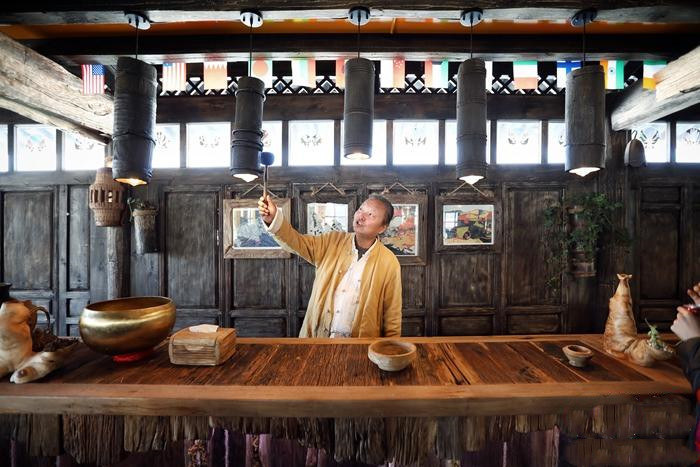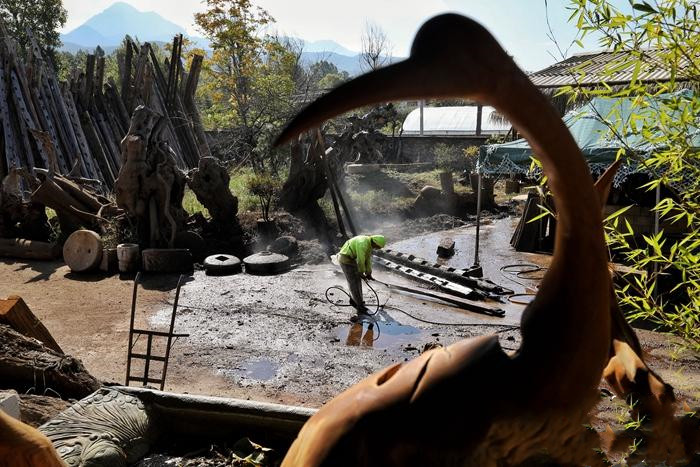It was a fine day. The noon sunlight was shining on the roof of the Adan Creative Furniture Plant, which is located in Lashi Town of Yulong County, northwest Yunnan’s Lijiang. On the ceiling of the plant hallway, there hang a number of horse bells once used by the caravans on the Ancient Tea-Horse Road. At a puff of wind, the bells sound pleasant jingles, as if they were sending greetings to tourists from all directions. 
“Using cultural creativity, trash can be turned into treasure,” said Adan, owner of the furniture plant, who received the interview at a two-storey bar built out of deserted logs. With his real name being Xie Wenxian, Adan graduated from National Taiwan University of Science and Technology, majoring Commercial Art Design. In the 1980s and 90s, Adan conducted a sort of thriving business in Taiwan. However, the tight schedule and frequent parties damaged his stomach, coupled with high cholesterol and dwindling eyesight. In 2001, Adan came to Lijiang by chance. Standing on flag-stoned streets of the old town, he caught sight of the snow-capped Jade Dragon Mountain afar. Around the town, folks in the Naxi, Tibetan, Bai and Yi ethnic costumes lead a life of leisure, wandering in the streets and alleys. “I came here just for recuperation,” said Adan, who kept a busy life style. In Lijiang, he noticed that many deserted logs were used as firewood. Feeling it is a pity, Adan decided to stay longer, renting a store for design of tourist souvenirs. Later, he invited his family to Lijiang, becoming the first Taiwan household settled therein. 
Lijiang used to be a key depot on the Ancient Tea-Horse Road, with caravans stopping here for a rest and artisans getting settled in succession. The left-behind antiques and relics make it possible for Adan to design in Lijiang. Three years ago, Adan purchased a deserted granary, recruiting 30 plus local artisans and a few Taiwan designers. Turning trash into treasure and regenerating aesthetics, they collected deserted logs and iron for recreation and built up the Panshi Creative Community. It is a place full of artistic air and vitality. “My wild imagination in design would make the folk artisans at loss.” In rendering ideas into artistic works, Adan encouraged local artisans to be creative. It was not easy at times, but the waste has been recycled and recreation is done anyway. Adan can still clearly remember what happened three years ago: The villagers used the granary as a dumping place, making it dirty and stinky. Then Adam and his team changed the place bit by bit, using their own hands. Now, worn logs and simi-finished products pile up in the creative plant, most shaped into bird-like figures. Adan said the surrounding area is a paradise for migrant birds, inspiring him a lot in creation. 
“A Naxi saying goes that man and nature are brothers, and we observe this.” In communicating with locals, Adan increased his reverence for nature. He said the log pieces have an existence of hundreds or even thousands of years, and humans are tiny beings before them. “I’m the first one to buy deserted logs in west Yunnan, most used as firewood. Now over 1,000 people from 300 families in Lijiang and Dali have joined me in collecting worn logs. They all opened their stores, creating an annual gross value of over 100 million yuan.” Adan said he is more than delighted in creating social wealth and contributing to local industries. When it came to the future plan, Adan said with a smile: “Who knows? Life is like a deserted log and it can shine when rightly placed. Now I feel all right every day. It’s just perfect.” Reporting by Li Xuefeng (China News Service); Trans-editing by Wang Shixue
|








7740f3b5-9ecb-438e-9052-76cb2d4bb671.jpg)

